
The “Ciudad Universitaria de Caracas”, a heritage work of the Venezuelan architect Carlos Raúl Villanueva and a team of architects, engineers, artists and qualified workers, began to build in the early years of the 40's, on the grounds of the para at that time Hacienda Ibarra. It is located in the city of Caracas, capital of the Republic of Venezuela, at 870 meters above sea level, the construction area reaches 164.2203 hectares. Everything was built with the most advanced technology of the moment and with a constructive quality that has been put to the test. The first part of the buildings, some forty, were ready to be inaugurated at the end of 1953. This set of works, of modern architecture, makes up what today is one of the most important centers of the city, surrounded by the main road arteries and through Los Caobos Park and the Botanical Garden mountain range, which is currently part of the university city complex.
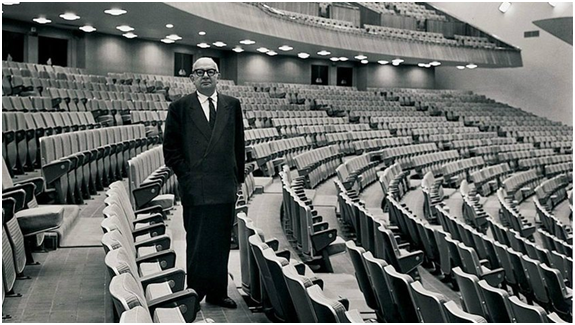
Villanueva's words indicate the understanding of the architect with his environment: “I like materials that due to their poverty, due to their plebeian sincerity, allow me to challenge the stupid conceit of exhibitionism. Among them I am particularly attracted to reinforced concrete, a symbol of the constructive progress of a whole century, rough, docile and strong as an elephant, monumental as stone, poor as brick..." Personal reflections (1965) Caracas, 1980, p. 80.
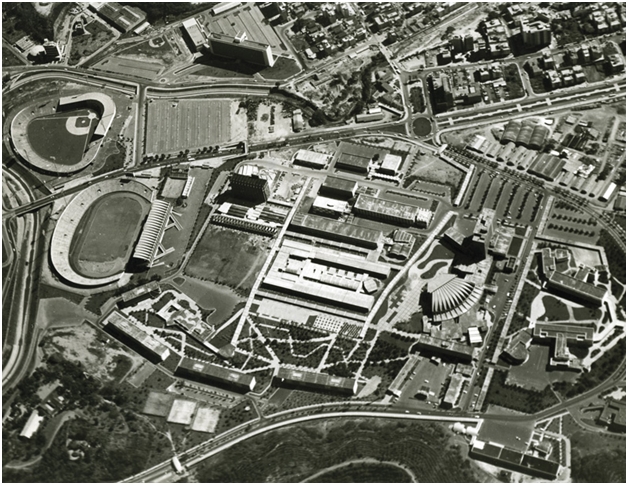
The first phase of the construction of the University City, had as its center the University Hospital, with 100 beds, surrounded by the units of the Faculty of Medicine, the Research Institutes and the Faculties of Pharmacy and Dentistry that would later keep it company, located all to the west; with the Rectorate buildings, Aula Magna and Central Library in the center and opposite these were the different faculties and the student residences, the service areas, culminating in the sports area and its two large stadiums. To the north of the complex was the Botanical Garden. All these buildings were connected by covered walkways, where the buildings are fully integrated with the gardens and works of art.

The campus currently has more than ninety buildings, which are the heart of the academic and recreational activity of the ucevistas, its main characteristic is that different and daring architectural designs converge in it, and architecture, art, and architecture converge harmoniously. Nature and man in a synthesis that has made it worthy of being declared a World Heritage Site by UNESCO in 2000.

The buildings house nine faculties, administrative and service support units, cultural centers, such as the famous Aula Magna, surrounded by works of art and internally with Calder's dishes guarding its grandeur, as well as buildings for the practice of many sports such as soccer, baseball, basketball, tennis, swimming in its various styles, gymnastics, table sports, etc., and the great university hospital, a jewel of architecture and once an internationally renowned medical studies center.

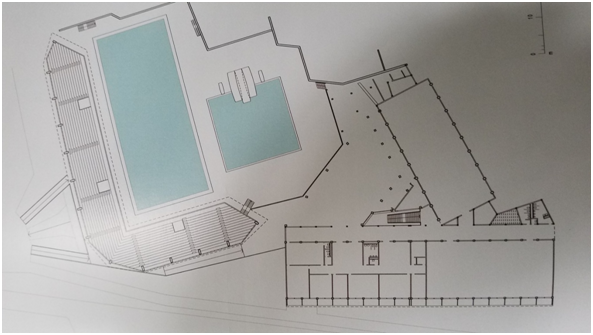
The University City is used by more than sixty thousand people daily, including students, teachers, administrative staff and workers, not counting the users of the University Hospital, some faculties that provide services to the public and visitors who come to enjoy their works. art, its buildings or some sporting or cultural activity that often takes place in the UCV facilities. When entering the university, the pedestrian or the driver finds, in the first place, a network of covered pedestrian walkways that are distributed throughout the complex to serve as a connection between their buildings. These corridors are a response to the climate, as they provide shade that is always appreciated in these tropical lands.

“The Ciudad Universitaria de Caracas” represents the dream come true of the great Venezuelan architect Carlos Raúl Villanueva and the team of professionals who worked under his direction, for almost two decades, to achieve the construction of this work of architectural art, the pride of Venezuelans. Villanueva emphasized the search to bring modern urbanism, architecture and art into conversation, a synthesis that would symbolize an ideal world of perfection for architecture and for the man who strives to give physical shape to the ideas that emerged as a result. of the philosophical, social, technological and aesthetic changes that occurred in previous centuries.
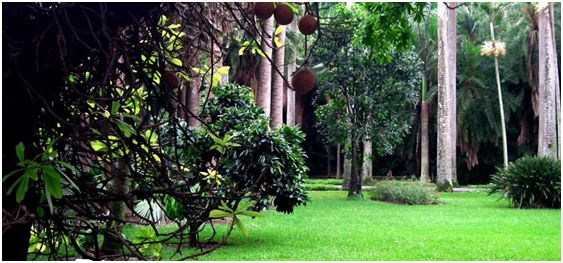
In 1993, by virtue of its architectural values, the University City of Caracas was declared a National Historical Monument by the National Board of Protection and Conservation of the Historical and Artistic Heritage of the Nation. In 2000, UNESCO decided to declare the University City of Caracas as a World Heritage Site, after more than 10 years of study, evaluation, visits and interviews by the officials of that organization, taking into consideration several variables. Such as: (I) Being a masterpiece of modern planning, architecture and avant-garde art. (II) To be an excellent example of the coherent realization of the urban, architectural, and artistic ideals of the 20th century, being an example of an opening and ventilation solution, appropriate for its tropical environment. A third criterion is constituted by the fact that the National Government made a public commitment to ensure its conservation, although, unfortunately, it did not comply with its promise despite having placed it under the umbrella of the national law that protects the conservation and preservation of heritage. cultural of the country. In January 2001, we received a visit from the Director General of UNESCO, Koichiro Matsuura, who formally delivered the declaration of World Heritage.
[ESP]La Ciudad Universitaria de Caracas: Patrimonio Mundial
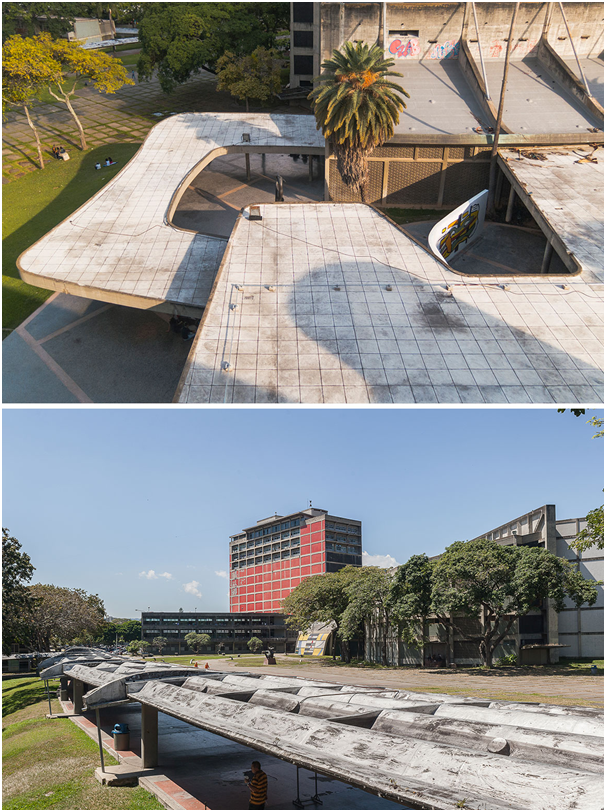
La Ciudad Universitaria de Caracas, patrimonial obra del arquitecto venezolano Carlos Raúl Villanueva y un equipo de arquitectos, ingenieros, artistas y obreros calificados, se inició a construir en los primeros años de la década de los 40´s, en los terrenos de la para ese entonces Hacienda Ibarra. Está situada en la ciudad de Caracas, capital de la República de Venezuela, a 870 mts sobre el nivel del mar, el área de construcción alcanza 164,2203 hectáreas. Todo fue construido con la tecnología más avanzada del momento y con una calidad constructiva puesta a toda prueba. La primera parte de las edificaciones, unas cuarenta, estuvieron listas para ser inauguradas a finales de 1953. Este conjunto de obras, de arquitectura moderna, conforma lo que hoy en día es unos de los centros más importantes de la ciudad, rodeado por las principales arterias viales y por el parque los Caobos y la serranía del Jardín Botánico, que actualmente forma parte del conjunto de la ciudad universitaria.
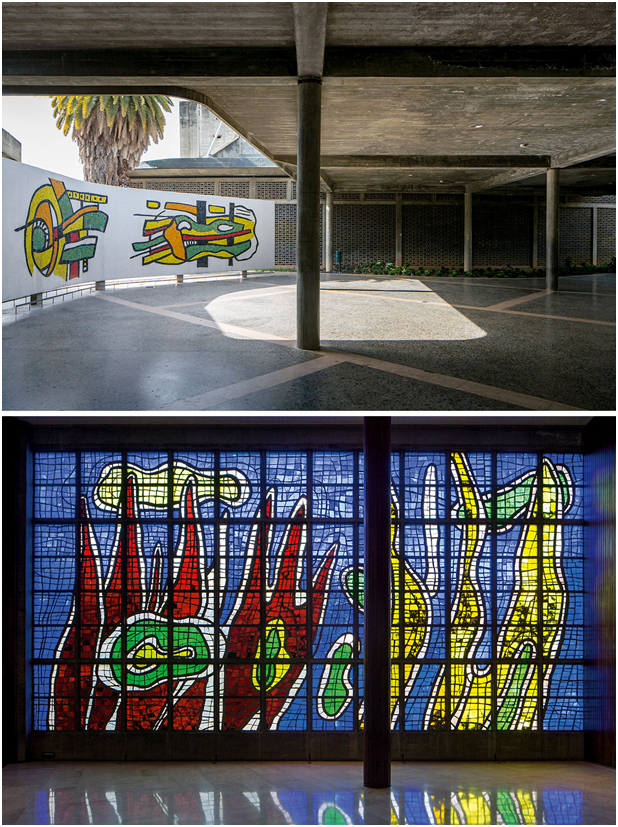
Las palabras de Villanueva nos indican la compenetración del arquitecto con su ambiente: “Me gustan los materiales que por su pobreza, por su sinceridad plebeya, me permiten desafiar al estúpido engreimiento del exhibicionismo. Entre ellos me atrae particularmente el concreto armado, símbolo del progreso constructivo de todo un siglo, rugoso, dócil y fuerte como un elefante, monumental como la piedra, pobre como el ladrillo…”
Reflexiones personales (1965) Caracas, 1980, p. 80.
La primera fase de la construcción de la Ciudad Universitaria, tenía como centro el Hospital Universitario, con 100 camas, rodeada de las dependencias de la Facultad de Medicina, los Institutos de investigación y las facultades de Farmacia y Odontología que le harían compañía posteriormente, ubicadas todas al oeste; con los edificios del Rectorado, Aula Magna y Biblioteca Central en el centro y frente a estos se ubicaban las diferentes facultades y las residencias estudiantiles, las áreas de servicios, culminando con la zona deportiva y sus dos grandes estadios. Al norte del conjunto se encontraba el Jardín Botánico. Todas estas edificaciones estaban conectadas por pasillos cubiertos, donde los edificios están plenamente integrados con los jardines y las obras de arte.
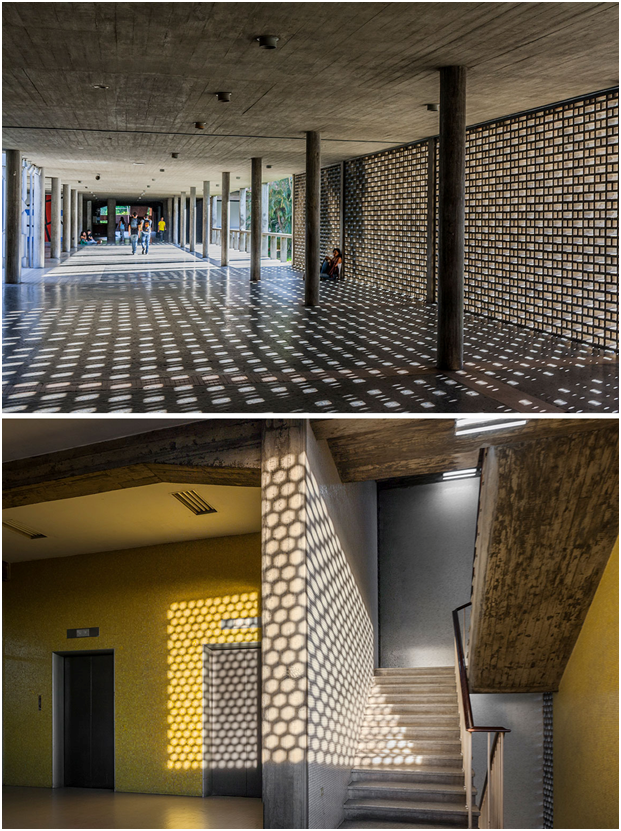
El campus tiene en la actualidad más de noventa edificaciones, que son el corazón de la actividad académica y de recreación de los ucevistas, su característica principal es que en él convergen distintos y atrevidos diseños arquitectónicos, y confluyen armoniosamente la arquitectura, el arte, la naturaleza y el hombre en una síntesis que la ha hecho merecedora de ser declarada Patrimonio de la Humanidad por la Unesco en 2000.
Las edificaciones cobijan a nueve facultades, dependencias de apoyo administrativo y de servicios, centros culturales, como la famosa Aula Magna, rodeada por obras de arte y a lo interno con los platillos de Calder custodiando su grandeza, así como edificaciones para la práctica de muchos deportes como el futbol, beisbol, basquetbol, tenis, natación en sus diversos estilos, gimnasia, deportes de mesa, etc., y el gran hospital universitario, joya de la arquitectura y otrora centro de estudios médicos de renombre internacional.
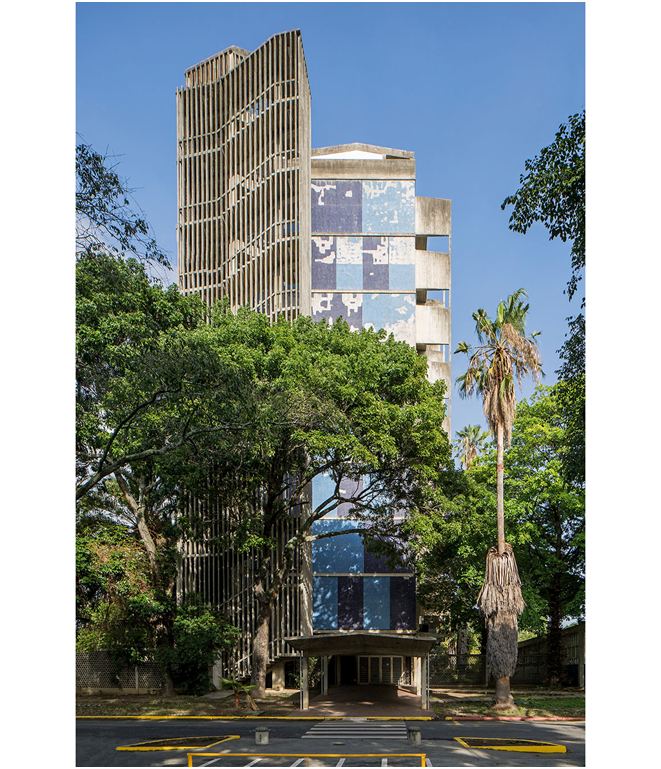
La Ciudad Universitaria es utilizada por más de sesenta mil personas diariamente, entre estudiantes, profesores, personal administrativo y obrero, sin contar los usuarios del Hospital Universitario, de algunas facultades que prestan servicio al público y de los visitantes que viene a disfrutar de sus obras de arte, sus edificaciones o de alguna actividad deportiva o cultural que a menudo se llevan a cabo en las instalaciones de la UCV. Al ingresar a la ciudad universitaria, el peatón o el conductor se encuentra, en primer lugar, con una red de pasillos peatonales cubiertos que se distribuyen a lo largo y ancho del conjunto para servir de conexión entre sus edificaciones. Estos pasillos son una respuesta al clima, pues proporcionan sombra que siempre se agradece en estas tierras tropicales.
La Ciudad Universitaria de Caracas representa el sueño hecho realidad del gran arquitecto venezolano Carlos Raúl Villanueva y el equipo de profesionales que trabajaron bajo su dirección, por casi dos décadas, para lograr construir esta obra de arte arquitectónico, orgullo de los venezolanos. Villanueva hizo énfasis en la búsqueda de lograr poner a conversar al urbanismo, la arquitectura y el arte modernos, síntesis que simbolizaría un mundo ideal de perfección para la arquitectura y para el hombre que se esmera por lograr darle forma física a las ideas surgidas a raíz de los cambios filosóficos, sociales, tecnológicos y estéticos ocurridos en los siglos anteriores.
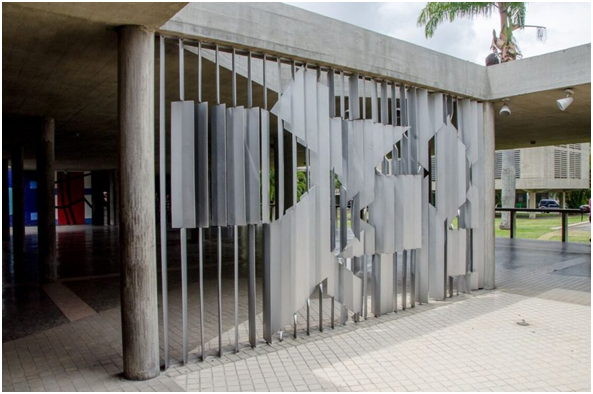
En 1993, en virtud de sus valores arquitectónicos, la Ciudad Universitaria de Caracas fue declarada Monumento Histórico Nacional por la Junta Nacional Protectora y Conservadora del Patrimonio Histórico y Artístico de la Nación. En el 2000, la UNESCO decidió declarar a la Ciudad Universitaria de Caracas como Patrimonio Mundial, luego de más de 10 años de estudio, evaluación, visitas y entrevistas por parte de los funcionarios de ese organismo, tomando en consideración varias variables. Tales como: (I) Ser una obra maestra de planeamiento moderno, arquitectura y arte vanguardista. (II) Ser un ejemplo excelente de la realización coherente de los ideales urbanos, arquitectónicos, y artísticos del siglo XX, siendo un ejemplo de solución de apertura y ventilación, apropiado para su entorno tropical. Un tercer criterio lo constituye el hecho de que el Gobierno Nacional se comprometió públicamente a asegurar su conservación, aunque, lamentablemente, no cumplió con la palabra empeñada a pesar de haberla puesto bajo el paraguas de la ley nacional que ampara la conservación y preservación del patrimonio cultural del país. En enero de 2001, recibimos la visita del Director General de la UNESCO, Koichiro Matsuura, quien hizo entrega formal de la declaratoria de Patrimonio Mundial.
Congratulations, your post has been added to Pinmapple! 🎉🥳🍍
Did you know you have your own profile map?
And every post has their own map too!
Want to have your post on the map too?
Congratulations @besamu! You have completed the following achievement on the Hive blockchain and have been rewarded with new badge(s) :
Your next target is to reach 200 upvotes.
You can view your badges on your board and compare yourself to others in the Ranking
If you no longer want to receive notifications, reply to this comment with the word
STOPCheck out the last post from @hivebuzz:
Support the HiveBuzz project. Vote for our proposal!
@tipu curate
Upvoted 👌 (Mana: 160/192) Liquid rewards.
Increible tu post sobre este gran hito arquitectonico
Gracias por sus palabras. Lamentablemente la ciudad universitaria ha sido descuidada en los últimos años y se encuentra en franco deterioro. Saludos cordiales. Esperamos iniciar una campaña internacional para salvarla lo más pronto posible
Lamento leer eso y sin duda es lo que toca, pedir apoyo para poder mantener nuestros hitos arquitectónicos porque el panorama nacional se ve peor
Hello Benjamín. It's an honor for this community to receive your great publication highlighting one of your country's national pride: the University City of Caracas, a UNESCO World Heritage Site. No wonder it's called a city due to its supermassive scale of building complexes and land area. I'd probably be lost on that campus if I roam around there on foot. Thank you for showcasing this remarkable treasure of architecture from your beautiful location!
Hello Erne, thank you for your words about my post, I have really enjoyed sharing the architectural beauty of the university city where I have spent part of my academic and personal life, including the sentimental one. I would like in the near future to make a post about the artistic part, both sculptures and murals in the various buildings and open spaces of the university city. Grateful, I say goodbye to you very cordially